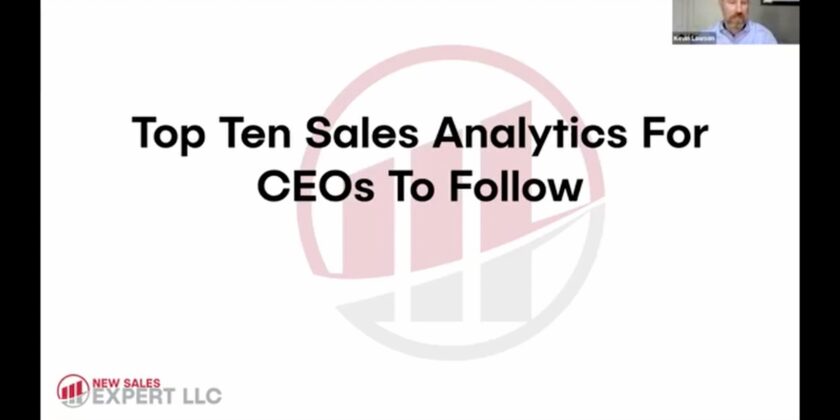Why should a company assess its practices in sales?

As a company owner, one of the most important aspects of running a successful business is setting and achieving sales objectives. But how do you determine what those objectives should be? Here’s a step-by-step guide to help you set realistic and achievable sales goals for your business.
Sales objectives are goals a company sets for its sales team to achieve over a certain period. These objectives can be anything from increasing revenue by a certain percentage to selling a certain number of products or services. Sales objectives should be set annually, but they can also be set for shorter periods such as quarters or months.
Let’s talk about the basic steps first.
- Define your overall goal.
- Break down your overall goal into smaller, more manageable goals.
- Create a timeline for each goal.
- Assign responsibility for each goal to a specific team member or department.
- Measure progress and revise objectives as needed.
- Celebrate accomplishments and learn from failures.
- Define your overall goal.
Sales goals are essential for any company regardless of size. They give you a target to aim for and help to motivate your sales team. Without a goal, getting complacent and falling into bad habits is easy.
It’s essential to clearly understand your company’s sales process before setting a goal. You need to know your closing rate, average deal size, and how many leads you need to generate to hit your target. Once you have this information, you can start to play around with different numbers to see what’s realistic.
Read the rest of the article…
A newsletter is one of the best tools you can use to maintain a relationship with your existing customers and qualified prospects that are uninterested in buying your product or service at this time. By sending out a newsletter quarterly, you can keep your brand top-of-mind so that when they are ready to make a purchase, they will think of your company first. You can reach an even wider audience by posting your newsletter on LinkedIn.
There are several benefits of sending a newsletter to your customers and qualified prospects, including:
- Keeping your brand top-of-mind: By sending out a quarterly newsletter, you can keep your brand top-of-mind so that when your customers or qualified prospects are ready to make a purchase, they will think of your company first.
- Developing a relationship with customers and qualified prospects: A newsletter is a great way to establish a relationship with your customers and qualified prospects. You can build trust and credibility with your readers by providing valuable information in each issue.
- Reaching a wider audience: Posting your newsletter to LinkedIn provides you with an opportunity to reach an even wider audience. When you post your newsletter on LinkedIn, include a call-to-action so that your readers know what you want them to do next.
- Generating leads: Including a call-to-action in each issue of your newsletter is a great way to generate leads.
- Increasing sales: By sending out a quarterly newsletter, you can increase sales by reminding your customers of the products or services they’ve purchased from you in the past and introducing them to new products or services that they may be interested in.
- Building customer loyalty: A newsletter is also a great way to build customer loyalty. By providing valuable information and helpful tips, you can show your customers that you value their business and are invested in helping them succeed.
- Enhancing customer service: In each issue of your newsletter, include contact information for customer service so that your readers know how to reach someone if they have questions or need assistance.
- Boosting morale: A well-written and informative quarterly newsletter can boost your employees’ morale by keeping them up-to-date on company news and developments.
Let’s explore these concepts even more.
Read the rest of the article…
I hope that you enjoy my September newsletter
Published: Tue, 09/13/22
|
Sean O’Shaughnessey
CEO and President
New Sales Expert LLC
Sean@NewSales.Expert
513.348.8700
6561 Bluegrass Way
Mason OH 45040
US
Unsubscribe | Change Subscriber Options

Every company wants its salespeople to be well-trained. After all, better-trained salespeople mean higher quality products and services, which leads to happier customers and increased sales. But with the training costs averaging $1,459 per salesperson, it’s important to ensure that your training budget is being spent in the most effective way possible. Here are four tips for getting the most out of your training budget.
- Prioritize Your Training Goals
The first step in making the most of your training budget is prioritizing your training goals. What skills do you want your employees to learn? What knowledge do they need to be able to do their jobs effectively? Once you’ve identified your goals, you can create a training plan to help your employees achieve them. - Invest in eLearning Programs
eLearning programs are a great way to train your employees without breaking the bank. Many different eLearning platforms are available, so you can find one that fits your company’s needs and budget. Plus, with eLearning, your employees can complete their training at their own pace and on their own time, which means they’re less likely to get overwhelmed or frustrated. - Use Technology to Your Advantage
Many types of technology can be used for training, from virtual reality simulations to online learning portals. By taking advantage of the latest technology, you can create a more immersive and effective training experience for your employees. Plus, using technology for training can help you save money by eliminating the need for travel and lodging expenses. - Consider External Training Programs
If you’re looking for more comprehensive or specialized training than what you can provide internally, consider partnering with an external training provider. These companies have the resources and expertise to develop custom training programs that meet your specific needs. And while external training programs can be more expensive than other options, they can also be more effective in helping your employees achieve their goals.
External training providers also offer the added benefit of scaling up or down as needed, which can help you save money in the long run.
To increase retention and effectiveness, companies should offer reps additional training at times of need, provide them with access to supplemental material that reinforces what they’ve already been taught, and allow them opportunities to practice their skills in time frames connected to actual buying processes. They can do so by using the same technologies that are “disrupting” their customer-contact activities: videos and mobile apps that reps can view on their devices before, during, and after training initiatives.
Role-Playing: The Secret to Sales Training Success
There’s one secret ingredient that can make all the difference: role-playing. Role-playing allows trainees to practice their new skills in a low-stakes environment by simulating real-world sales scenarios. Not only that, but role-playing also helps trainees to better understand their customers’ needs and how to best meet them. As a result, role-playing is essential to any successful sales training program.
Read the rest of the article…
March brings March Madness. March Madness is the college basketball tournament where the 64 teams battle to find out who is the best college basketball team of the season.
While you are watching your team this year, I would like you to learn a lesson that every basketball coach has had to learn. The easiest way to learn this lesson is to do a little analysis. I would like you to count the number of times where the game is tight, one team is on the free-throw line, and the coach makes a substitution – himself.
Yes, count the number of times the coach doesn’t trust the player he has been coaching all season and puts himself on the line to make that winning shot.
I can already tell you the number: zero.
During a game, the coach can rant, rave, coach, and cajole but he cannot play the game. He has to trust that the athletes that he has coached all season will take his instruction, remember the skills that they have practiced, and execute those plays as they were taught.
This doesn’t happen in sales. It is almost commonplace for the coach (the sales manager) to step in and drive the conversation. He puts his athlete, whom he has been coaching perhaps for years, on the bench.
So, let’s explore what would happen if suddenly you were required to stay on the sidelines while you watched your salespeople sell and it was impossible for you to take over the sale.
Read the rest of the article…
The global pandemic has caused crisis after crisis to hit US companies. These crises include:
- global supply chain problems affecting worldwide shipping
- increased prices due to the shortage of components or subassemblies
- labor shortages
To assist our clients, Sean O’Shaughnessey and Kevin Lawson teamed up to create the following webinar. The webinar originally aired on January 13, 2022.
The following is a transcript of the webinar video above. It has been sparsely edited to increase its readability, but many of the idioms and poor spoken grammar have been left in place. The transcription was automatically generated by Sonix.ai and, as capable as that product is, there are times when words are missed or sentence structure was incorrectly interpreted. We have tried to catch all of these software misses, but we are confident that some still remain. The below text is provided for those that would rather read than watch a video.
Read the rest of the article…

I was recently interviewed by Bob Clark on his podcast 808 Podcast. It is named 808 because 808 looks like Bob and the internet loves short video content so it is less than 8 minutes and 8 seconds. We had a great conversation in under 8 minutes and 8 seconds while Bob walked me through four high-level questions (and a few clarifying questions).
I went through the process of having the conversation transcribed so that you can read the content if you prefer to read more than listen. This transcription tries to put the text into a more readable format.
You can find the podcast here. At the bottom of this article, there is a YouTube version of the podcast.
Are you experiencing any of the following common sales issues?
- Inability to take sales “to the next level”
- Difficulty finding the “right” salesperson for your company
- Not sure where to start – “I don’t know what I don’t know”
- Lack of a formal sales process
- Stalled out proposals
- Not being able to effectively articulate the value proposition, solution or service
Great companies deserve a great plan
You have developed incredible offerings. You have solid leadership in place. Yet, you still need some help with improving your sales productivity.
Let the Genesis Sales Plan by Sales Xceleration and delivered by New Sales Expert LLC provide you with the structure and key personnel needed to surpass your goals.
Your sales vision statement should be a clear, concise, and future-focused declaration of where you want your sales efforts to lead and the path you’ll take to get there.
- Clear
- Concise
- Future-focused
- Destination-driven
- Path-Oriented
- Inspiring and empowering
With such a critical tool in place, your sales team can boost sales by looking forward. If you do not know how to create such a plan, we are happy to help you. Please contact us via our Contact page and we will sit down with you to discuss how we can help you accelerate your revenue.










You must be logged in to post a comment.